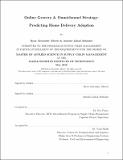| dc.description.abstract | The traditional way to reach customers in e-commerce is home delivery. Retailers have expanded fulfillment options to include picking up from a store, locker, 3rd-party collection point, and more. This study focuses on two channels: pick-up from the store and home delivery.
Groceries present a unique category for eCommerce due to particularly onerous complications from last-mile delivery of fresh products. Existing research is lacking in comparisons of channel options in the context of online grocery that capture interactions of channel and customer attributes. This study identifies critical markets for home delivery of online grocery and provides insights into drivers of channel choice in this context. It does so by first modelling home delivery adoption – applying machine-learning algorithms to historical customer data – and then analyzing channel preferences via a Discrete Choice Experiment devised by the authors expressly for this study.
The study quantifies the importance of geographic features in home delivery adoption, including density of existing online grocery customers and their distance from a store. The study also quantifies the likelihood of customer channel preference given varying channel attributes; for example, a customer is no more likely to choose pick-up from store if it is ready today vs. tomorrow. | en_US |
